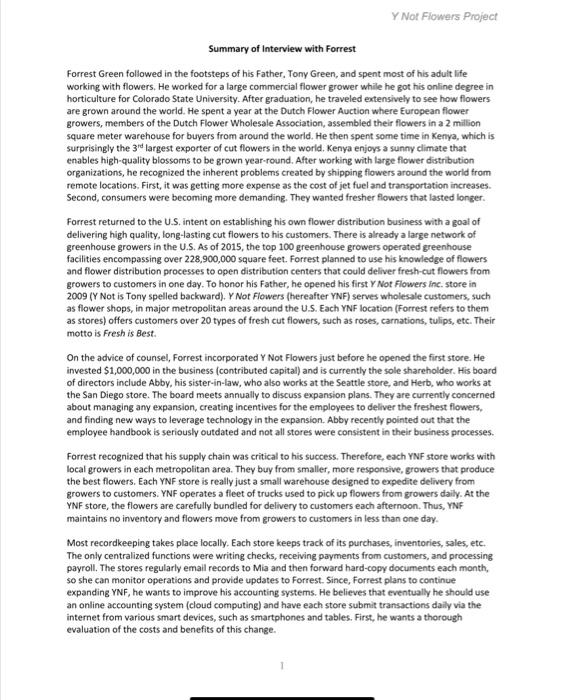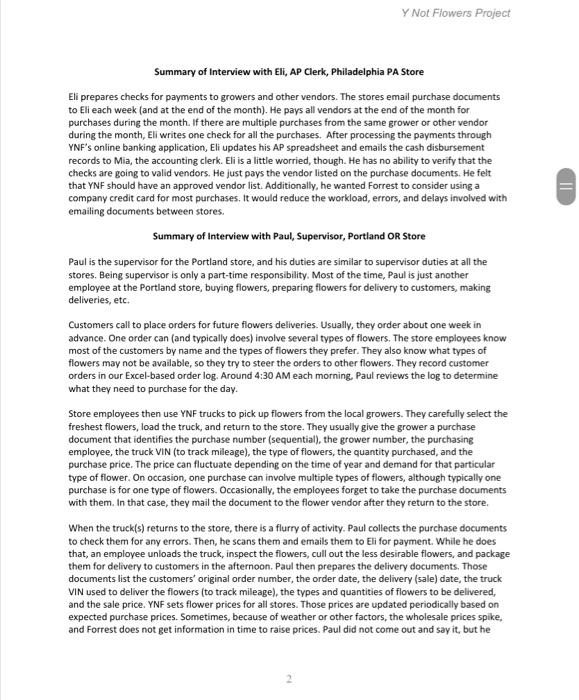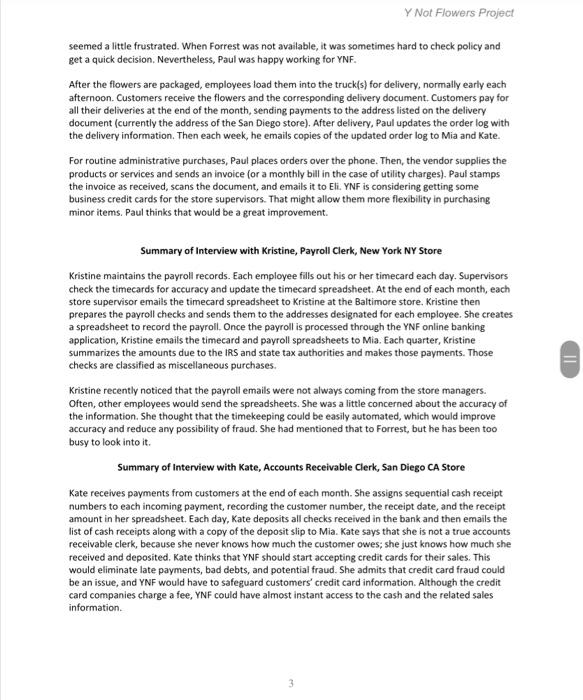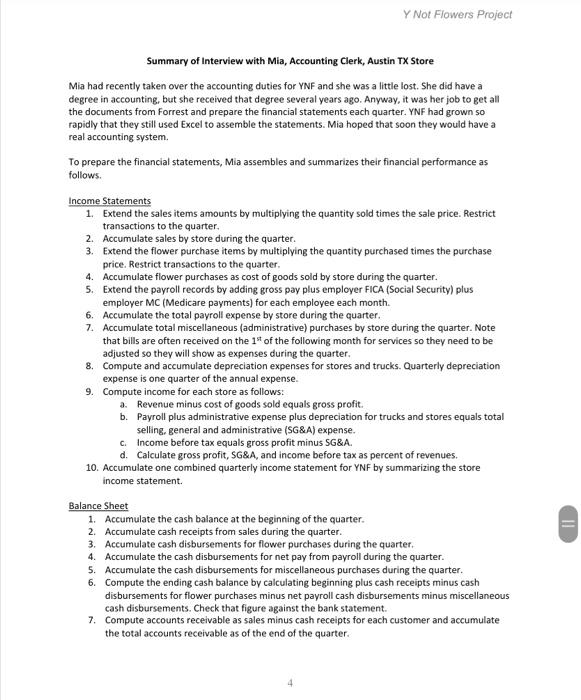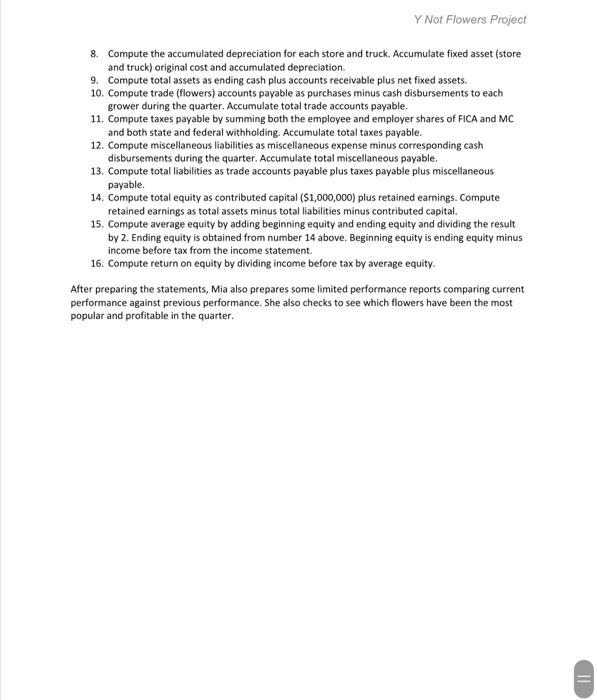Y not Flowers. Based on the interviews, document business processes of YNF using BPMN. Please ignore miscellaneous purchases/taxes.
1) Sales
2) Administrative Purchases
3) Payroll
Y Not Flowers Project Summary of Interview with Forrest Forrest Green followed in the footsteps of his Father, Tony Green, and spent most of his adult life working with flowers. He worked for a large commercial flower grower while he got his online degree in horticulture for Colorado State University. After graduation, he traveled extensively to see how flowers are grown around the world. He spent a year at the Dutch Flower Auction where European flower growers, members of the Dutch Flower Wholesale Association, assembled their flowers in a 2million square meter warehouse for buyers from around the world. He then spent some time in Kenya, which is surprisingly the 3rd largest exporter of cut flowers in the world. Kenya enjoys a sunny climate that enables high-quality blossoms to be grown year-round. After working with large flower distribution organizations, he recognized the inherent problems created by shipping flowers around the world from remote locations. First, it was getting more expense as the cost of jet fuel and transportation increases. Second, consumers were becoming more demanding. They wanted fresher flowers that lasted longer. Forrest returned to the U.S. intent on establishing his own flower distribution business with a goal of delivering high quality, long-lasting cut flowers to his customers. There is already a large network of greenhouse growers in the U.S. As of 2015, the top 100 greenhouse growers operated greenhouse facilities encompassing over 228,900,000 square feet. Forrest planned to use his knowledge of flowers and flower distribution processes to open distribution centers that could deliver fresh-cut flowers from growers to customers in one day. To honor his Father, he opened his first Y Not Flowers inc. store in 2009 (Y Not is Tony spelled backward). Y Not Flowers (hereafter YNF) serves wholesale customers, such as flower shops, in major metropolitan areas around the U.S. Each YNF location (Forrest refers to them as stores) offers customers over 20 types of fresh cut flowers, such as roses, carnations, tulips, etc. Their motto is Fresh is Best. On the advice of counsel, Forrest incorporated Y Not Flowers just before he opened the first store. He invested $1,000,000 in the business (contributed capital) and is currently the sole shareholder. His board of directors include Abby, his sister-in-law, who also works at the Seattle store, and Herb, who works at the San Diego store. The board meets annually to discuss expansion plans. They are currently concerned about managing any expansion, creating incentives for the employees to deliver the freshest flowers, and finding new ways to leverage technology in the expansion. Abby recently pointed out that the employee handbook is seriously outdated and not all stores were consistent in their business processes. Forrest recognized that his supply chain was critical to his success. Therefore, each YNF store works with local growers in each metropolitan area. They buy from smaller, more responsive, growers that produce the best flowers. Each YNF store is really just a small warehouse designed to expedite delivery from growers to customers. YNF operates a fleet of trucks used to pick up flowers from growers daily. At the YNF store, the flowers are carefully bundled for delivery to customers each afternoon. Thus, YNF maintains no inventory and flowers move from growers to customers in less than one day. Most recordkeeping takes place locally. Each store keeps track of its purchases, inventories, sales, etc. The only centralized functions were writing checks, receiving payments from customers, and processing payroll. The stores regularly email records to Mia and then forward hard-copy documents each month, so she can monitor operations and provide updates to Forrest. Since, Forrest plans to continue expanding YNF, he wants to improve his accounting systems. He believes that eventually he should use an online accounting system (cloud computing) and have each store submit transactions daily via the internet from various smart devices, such as smartphones and tables. First, he wants a thorough evaluation of the costs and benefits of this change. Summary of Interview with Eli, AP Clerk, Philadelphia PA Store Eli prepares checks for payments to growers and other vendors. The stores email purchase documents to Eli each week (and at the end of the month). He pays all vendors at the end of the month for purchases during the month. If there are multiple purchases from the same grower or other vendor during the month, Eli writes one check for all the purchases. After processing the payments through YNF's online banking application, Eli updates his AP spreadsheet and emails the cash disbursement records to Mia, the accounting clerk. Eli is a little worried, though. He has no ability to verify that the checks are going to valid vendors. He just pays the vendor listed on the purchase documents. He felt that YNF should have an approved vendor list. Additionally, he wanted forrest to consider using a company credit card for most purchases. It would reduce the workload, errors, and delays involved with emailing documents between stores. Summary of Interview with Paul, Supervisor, Portland OR Store Paul is the supervisor for the Portland store, and his duties are similar to supervisor duties at all the stores. Being supervisor is only a part-time responsibility. Most of the time, Paul is just another employee at the Portland store, buying flowers, preparing flowers for delivery to customers, making deliveries, etc. Customers call to place orders for future flowers deliveries. Usually, they order about one week in advance. One order can (and typically does) involve several types of flowers. The store employees know most of the customers by name and the types of flowers they prefer. They also know what types of flowers may not be available, so they try to steer the orders to other flowers. They record customer orders in our Excel-based order log. Around 4:30 AM each morning, Paul reviews the log to determine what they need to purchase for the day. Store employees then use YNF trucks to pick up flowers from the local growers. They carefully select the freshest flowers, load the truck, and return to the store. They usually give the grower a purchase document that identifies the purchase number (sequential), the grower number, the purchasing employee, the truck VIN (to track mileage), the type of flowers, the quantity purchased, and the purchase price. The price can fluctuate depending on the time of year and demand for that particular type of flower. On occasion, one purchase can involve multiple types of flowers, although typically one purchase is for one type of flowers. Occasionally, the employees forget to take the purchase documents with them. In that case, they mail the document to the flower vendor after they return to the store. When the truck(s) returns to the store, there is a flurry of activity. Paul collects the purchase documents to check them for any errors. Then, he scans them and emails them to Eli for payment. While he does that, an employee unloads the truck, inspect the flowers, cull out the less desirable flowers, and package them for delivery to customers in the afternoon. Paul then prepares the delivery documents. Those documents list the customers' original order number, the order date, the delivery (sale) date, the truck VIN used to deliver the flowers (to track mileage), the types and quantities of flowers to be delivered, and the sale price. YNF sets flower prices for all stores. Those prices are updated periodically based on expected purchase prices. Sometimes, because of weather or other factors, the wholesale prices spike, and Forrest does not get information in time to raise prices. Paul did not come out and say it, but he seemed a little frustrated. When Forrest was not available, it was sometimes hard to check policy and get a quick decision. Nevertheless, Paul was happy working for YNF. After the flowers are packaged, employees load them into the truck(s) for delivery, normally early each afternoon. Customers receive the flowers and the corresponding delivery document. Customers pay for all their deliveries at the end of the month, sending payments to the address listed on the delivery document (currently the address of the San Diego store). After delivery, Paul updates the order log with the delivery information. Then each week, he emails copies of the updated order log to Mia and Kate. For routine administrative purchases, Paul places orders over the phone. Then, the vendor supplies the products or services and sends an invoice (or a monthly bill in the case of utility charges). Paul stamps the invoice as received, scans the document, and emails it to Eli. YNF is considering getting some business credit cards for the store supervisors. That might allow them more flexibility in purchasing minor items. Paul thinks that would be a great improvement. Summary of Interview with Kristine, Payroll Clerk, New York NY Store Kristine maintains the payroll records. Each employee fills out his or her timecard each day. Supervisors check the timecards for accuracy and update the timecard spreadsheet. At the end of each month, each store supervisor emails the timecard spreadsheet to Kristine at the Baltimore store. Kristine then prepares the payroll checks and sends them to the addresses designated for each employee. She creates a spreadsheet to record the payroll. Once the payroll is processed through the YNF online banking application, Kristine emails the timecard and payroll spreadsheets to Mia. Each quarter, Kristine summarizes the amounts due to the IRS and state tax authorities and makes those payments. Those checks are classified as miscellaneous purchases. Kristine recently noticed that the payroll emails were not always coming from the store managers. Often, other employees would send the spreadsheets. She was a little concerned about the accuracy of the information. She thought that the timekeeping could be easily automated, which would improve accuracy and reduce any possibility of fraud. She had mentioned that to Forrest, but he has been too busy to look into it. Summary of Interview with Kate, Accounts Receivable Clerk, San Diego CA Store Kate receives payments from customers at the end of each month. She assigns sequential cash receipt numbers to each incoming payment, recording the customer number, the receipt date, and the receipt amount in her spreadsheet. Each day, Kate deposits all checks received in the bank and then emails the list of cash receipts along with a copy of the deposit slip to Mia. Kate says that she is not a true accounts receivable clerk, because she never knows how much the customer owes; she just knows how much she received and deposited. Kate thinks that YNF should start accepting credit cards for their sales. This would eliminate late payments, bad debts, and potential fraud. She admits that credit card fraud could be an issue, and YNF would have to safeguard customers' credit card information. Although the credit card companies charge a fee, YNF could have almost instant access to the cash and the related sales information. Summary of Interview with Mia, Accounting Clerk, Austin TX Store Mia had recently taken over the accounting duties for YNF and she was a little lost. She did have a degree in accounting, but she received that degree several years ago. Anyway, it was her job to get all the documents from forrest and prepare the financial statements each quarter. YNF had grown so rapidly that they still used Excel to assemble the statements. Mia hoped that soon they would have a real accounting system. To prepare the financial statements, Mia assembles and summarizes their financial performance as follows. Income Statements 1. Extend the sales items amounts by multiplying the quantity sold times the sale price. Restrict transactions to the quarter. 2. Accumulate sales by store during the quarter. 3. Extend the flower purchase items by multiplying the quantity purchased times the purchase price. Restrict transactions to the quarter. 4. Accumulate flower purchases as cost of goods sold by store during the quarter. 5. Extend the payroll records by adding gross pay plus employer FICA (Social Security) plus employer MC (Medicare payments) for each employee each month. 6. Accumulate the total payroll expense by store during the quarter. 7. Accumulate total miscellaneous (administrative) purchases by store during the quarter. Note that bills are often received on the 1st of the following month for services so they need to be adjusted so they will show as expenses during the quarter. 8. Compute and accumulate depreciation expenses for stores and trucks. Quarterly depreciation expense is one quarter of the annual expense. 9. Compute income for each store as follows: a. Revenue minus cost of goods sold equals gross profit. b. Payroll plus administrative expense plus depreciation for trucks and stores equals total selling, general and administrative (SG\&A) expense. c. Income before tax equals gross profit minus SG\&A. d. Calculate gross profit, $G&A, and income before tax as percent of revenues. 10. Accumulate one combined quarterly income statement for YNF by summarizing the store income statement. Balance Sheet 1. Accumulate the cash balance at the beginning of the quarter. 2. Accumulate cash receipts from sales during the quarter. 3. Accumulate cash disbursements for flower purchases during the quarter. 4. Accumulate the cash disbursements for net pay from payroll during the quarter. 5. Accumulate the cash disbursements for miscellaneous purchases during the quarter. 6. Compute the ending cash balance by calculating beginning plus cash receipts minus cash disbursements for flower purchases minus net payroll cash disbursements minus miscellaneous cash disbursements. Check that figure against the bank statement. 7. Compute accounts receivable as sales minus cash receipts for each customer and accumulate the total accounts receivable as of the end of the quarter. Y Not Flowers Project 8. Compute the accumulated depreciation for each store and truck. Accumulate fixed asset (store and truck) original cost and accumulated depreciation. 9. Compute total assets as ending cash plus accounts receivable plus net fixed assets. 10. Compute trade (flowers) accounts payable as purchases minus cash disbursements to each grower during the quarter. Accumulate total trade accounts payable. 11. Compute taxes payable by summing both the employee and employer shares of FICA and MC and both state and federal withholding. Accumulate total taxes payable. 12. Compute miscellaneous liabilities as miscellaneous expense minus corresponding cash disbursements during the quarter. Accumulate total miscellaneous payable. 13. Compute total liabilities as trade accounts payable plus taxes payable plus miscellaneous payable. 14. Compute total equity as contributed capital ($1,000,000) plus retained earnings. Compute retained earnings as total assets minus total liabilities minus contributed capital. 15. Compute average equity by adding beginning equity and ending equity and dividing the result by 2 . Ending equity is obtained from number 14 above. Beginning equity is ending equity minus income before tax from the income statement. 16. Compute return on equity by dividing income before tax by average equity. After preparing the statements, Mia also prepares some limited performance reports comparing current performance against previous performance. She also checks to see which flowers have been the most popular and profitable in the quarter
